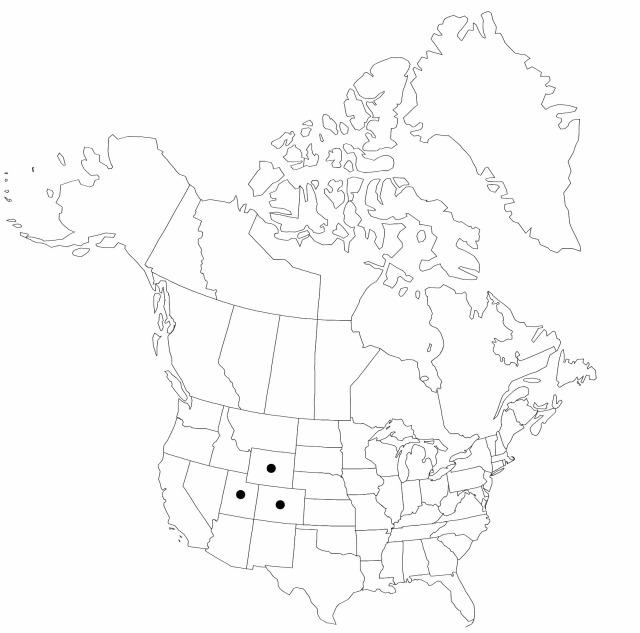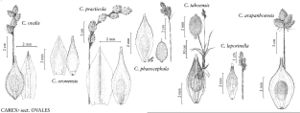Carex arapahoensis
Rhodora 21: 83. 1919.
Plants densely cespitose. Culms 20–30 cm. Leaves: sheaths white-hyaline, summits usually U-shaped; distal ligules 1–2(–2.5) mm; blades 3(–5) per fertile culm, 10–40 cm × 2.2–3.2 mm. Inflorescences dense or sometimes open proximally, brown or purplish, 1.2–2(–2.5) cm × (8–)12–18 mm; proximal internode 1.5–3.5 mm; 2d internode 0.5–2.5 mm; proximal bracts bristlelike, shorter than inflorescences. Spikes 4–5, densely aggregated, usually at least proximal 1 distinct, obovoid, 9–12 × (5.5–)7–9 mm, base rounded or attenuate, apex rounded or acute. Pistillate scales red- or purple-brown to dark brown, sometimes gold above the middle, sometimes with paler midstripe, ovate to broadly ovate, 4.3–5.6 mm, shorter than or equaling perigynium beaks, equaling or narrower than perigynia, margin white-hyaline, green, or gold 0.15–0.3 mm wide, apex usually acute. Anthers long-persistent. Perigynia appressed to ascending, usually dark brown, often green or gold distally and at margins, veinless or conspicuously 3–6-veined abaxially, inconspicuously veined adaxially, broadly obovate to broadly ovate, flat except over achene, 4–5.5 × 2–2.7 mm, 0.25–0.4(–0.5) mm thick, margin flat, including wing 0.4–0.6 mm wide, ciliate-serrulate at least on distal body; beak purplish or brown to red-brown, white-hyaline at tip, cylindric, unwinged, entire for 0.5–1.3 mm from tip, abaxial suture with conspicuous white margin, distance from beak tip to achene (1.9–)2.2–2.9 mm. Achenes obovate or ovate, 1.6–2.1 × 1–1.4 mm, 0.3–0.5 mm thick.
Phenology: Fruiting late summer.
Habitat: Dry mountainsides, high meadows
Elevation: 3400–4000 m
Distribution

Colo., Utah, Wyo.
Discussion
Of conservation concern.
Selected References
None.
